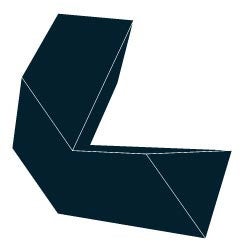Remind your child that everything we see has a size. Even among the same types of things, some can be larger or smaller. For instance, a toy car is a small version of a real car that an adult drives. If the toy car looks exactly like the larger one, except for its size, then we say it is a scale model.
This artist worked by making small cardboard shapes and arranging them in different orders to make a model. He would then have a larger sculpture made out of steel that looked exactly the same, only bigger.
What size is this sculpture? Is it large or small?
What size do you think was the artist’s model?
Can you see shapes in the sculpture? Which ones?
How do you think they are put together?
Examine the size of the sculpture and ask the child to think of things that are the same size. Note that this sculpture uses elemental shapes, like triangles and rectangles, in unusual ways.
Using the cardboard, make three-dimensional shapes for your child to use. They may be cubes, pyramids, spheres, etc. Ask the child to assemble them in ways that make new shapes and tape them together. Take the model outside and encourage the child to imagine a large- scale version. How big would it be (as big as a car or house?), and where would you put it?
Artist - someone who makes things, such as paintings and sculptures
Model - a small version of a large thing Scale - to change the size of something from smaller to larger or larger to smaller
Sculpture - a work of art that has height, width, and depth
Shape - an outline of a body, like a circle or square *Steel* - a strong metal used in buildings

